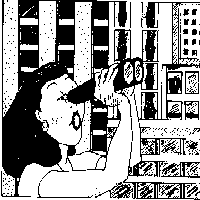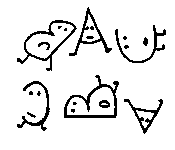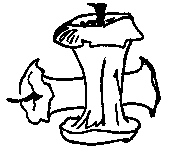

Getting Something on Paper |
|---|
|
The Line Myth I Just Want to Look Exploration - M & S The Buzz Getting Serious Additional Reading |
The Line MythIf the hunger fund could collect a nickel for every time someone said, "I love art, but I can't draw a straight line," world hunger would disappear. The statement implies that drawing is hopeless. They can't draw a straight line or anything else. The implication is wrong. To my knowledge, everyone who made that statement could write. This ability to write means more than an occasional thank-you note. It means that your years of outlines, notes, and letters have developed your core drawing skills. You already know the shapes and figures involved in drawing; you already know how to use a pencil. Drawing involves a few adjustments to your writing skills. It might require larger shapes, or heavier lines. This is not a big deal. I Just Want to LookOkay. The ability to look at art with insight is so important that an argument against "just looking" would not be appropriate. 
If you just want to look, don't let anything said here sway you. You are on a solid path. However...Experiencing an activity adds an insight that just isn't possible with simply observing. For example: So...a few drawing exercises are a worthy effort, regardless of the outcome. You have the core skills from writing, and there is an outside chance a hidden talent will surface. That's what exploration is about. If your skills were set in stone, there would be no such thing as discovery. Exploration - M & SYou already know a lot about drawing. If you can print an M and an S, you know the basic moves in drawing. What you don't know is how to do it on a larger scale. Most likely, you're used to half-inch size letters. Your hands and arms are set for those motions. 
A great exercise would be to write out the alphabet ten inches tall, two hundred times a day. But that would be incredibly boring. Let's not do that. Cool ExerciseLooking for the center of interest in a painting was fun. Let's use that as a focus rather the alphabet. Here we go: Remember, the goal here is to get your hand and arm use to making larger motions. If it feels strange, that's good, it's working. 
If one motion feels particularly difficult, shrink it down to letter size. You already know how to make those shapes. Once that feels better, try it a bit larger. The BuzzAfter a few sketches, you might notice a buzz. It's that little voice in the back of your mind saying, "I could do this. This is fun." Please don't ignore the buzz. There are few things in life that offer personal pleasure. Don't miss a chance to embrace it. Getting RegularOne sketch does not a mountain make. To grow your talent, you need practice. The key is to make training an enjoyable, natural part of your daily routine. Comments: An exercise: Over time, your eye for catchy scenes will sharpen; your hand will move more freely; and you will feel a new dimension growing in your life. Getting SeriousAfter a while the urge to get better will hit. You'll want to do a better job capturing the waiter's lean, or the dancer's strut.
Santa Barbara Days, 1993
Good news here. Texts on figure drawing abound, and they are very good at guiding you through the lines that make up landscapes and human gestures. Their step-by-step approaches make them perfect for self-study. Even when your sketches are rough, you'll be amazed at how much sense of a place can be captured in a simple line drawing. Again, drawing isn't that different from your writing skills, so it will be familiar in many ways. Not Serious Yet?Even if you're not yet serious, the next section should be stimulating. It discusses how to add mood into your sketches. Additional Reading
The Natural Way to Draw
by Kimon Nicolaides. Mariner, 1941, 1990.
Rendering in Pen and Ink
by Arthur L. Guptill. Watson-Guptill Publications, 1997.
Drawing: A Creative Process
by Francis Ching. John Wiley, 1997.
Drawing the Landscape
by Chip Sullivan. John Wiley, 1997. Hard to Find Books Most books can be ordered through Amazon.com by clicking on the book's title link. If the book is not available or out-of-print, Amazon.com and Barnes and Noble list vendors with used copies. | AWSS Main | Previous Section | Next Section | Feedback: Patricia Bason |